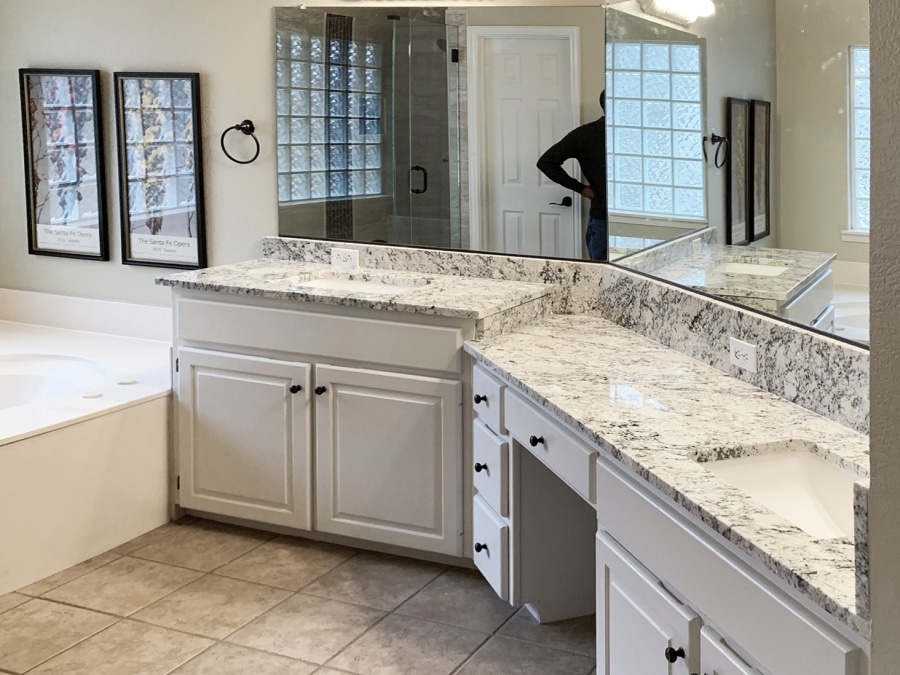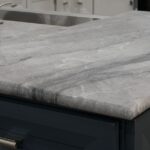When looking to give our kitchen an upgrade, we tend to look for more affordable and easy ways to do so. Even some DIY’s come along on the list at that moment! And liquid granite, or epoxy countertops, is quite a famous choice for a DIY. But is it worth it? What can be the disadvantages of liquid granite? We’ll tell you all about in the following sections.
Do you want to know more about natural granite and how it makes for a good countertop? We’ve got you covered! Check out our definitive guide on granite countertops! It’s got all the information you need to decide on your next countertop.
What is Liquid Granite?
Liquid granite may be used to fix a variety of issues, including holes and cracks in your countertop, as well as to create a whole new countertop. This is a type of resin epoxy that has been combined with carefully chosen aggregates that helps it resemble granite as it is poured into the specific surface. It comes in a sort of bucket that allows it to be easily transported to the location of repair, and it simply has to be combined with water to form.
The liquid granite can be water-resistant, but not so much heat-resistant, as the heat can easily pass through it and reach the surface underneath it. But it is believed to be a long-lasting and simple-to-use product. But there’s more to it. To apply it, you’ll need a complete setup to avoid spilling it and enable it to harden completely. Some can even themselves out, but some require a little more preparation and tools to be completely even.
It can come in spray form or in a bucket. It is usually a mix between two substances, and then you apply over the surface you want it to form over. You won’t find a countertop to buy in that form, you can only make it from scratch.
And, although rarer, some people use it on floors and walls to resemble granite as well. This process requires much more preparation as they are harder areas to pour over. For walls, it is better to get the full spray equipment, as it will apply better to the vertical surface.
Where can liquid granite be applied?
It can typically be applied to a lot of materials, such as:
- Laminate
- Ceramic
- Metal
- Wood
- Concrete
It is rarely used over already existing granite or marble countertops, but it can be done. And most people who do so typically do it to spruce up an old stone or change the color to match the new kitchen. But is all this work worth it? Wouldn’t just be getting a freshly cut, beautiful, new stone, easier?
Disadvantages of liquid granite
Liquid granite made at home might be difficult to manage. A resin and a hardener are combined to make it. And both ingredients are offered as liquids and, when combined, solidify. As we’ll see shortly, this procedure has a number of disadvantages:
Hard to apply, even with professionals
As soon as it starts, you have to evacuate the kitchen. As this is a highly chemical process, you need to keep your windows open and leave the kitchen for it to harden. The chemical reaction releases chemicals as vapors into the air, and they can be quite toxic.
To avoid a bumpy surface and air bubbles, epoxy must be applied uniformly. If you aren’t careful, you may wind up having to remove the epoxy and start over, losing both time and material.
Even if the epoxy you picked is self-leveling, it will leave little droplets along the borders once it has dried. And once hardened, they are extremely difficult to clean.
Takes a lot of time to install
Above all the means you need to install it, the process itself takes a long time. Even merely the preparation entails a variety of steps. Take the time to carefully prepare the surface. Because, in addition to being clean, the surface may need to be sanded, and even with a sanding machine this can take more than a day. In addition, you must cover everything surrounding the area you are applying it on with plastic sheeting. It hardens once it hardens!
The curing process can take 24 hours or more. But it is not until a week after that you can really put it through stress and weights. It hardens really quickly, but it is only not prone to damage, bending or denting within a week.
There are no second chances
If you don’t really like the final design, the bad news is that you need to keep it. Unless you want to do the whole process all over again, you just have to accept it. If you made a mistake or damaged the area during the curing process, you may need to remove everything and start over.
They are not stain-resistant
Have you ever noticed that some plastic materials, from Tupperware to your white fridge, can get a little stained over time? Some discolor and some get a little yellow, but they all eventually stain.
What to use instead of liquid granite?

On top of all the disadvantages, the full cost of a liquid granite surface is not comparable to a real stone! The cost-benefit of getting a new, beautiful stone can’t be discussed. You will choose a more durable, stain and heat-resistant material that can match exactly what you dream for your kitchen!
Talk to our experts by clicking here and get a free quote!



